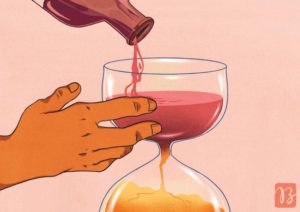How to Figure Out if Moderate Drinking Is Too Risky for You
By Lydia Denworth | October 1, 2023 | Scientific American | Topics: Health, Science and Health
New research shows any alcohol can harm your body, but the increased risk may not be huge
Wine with dinner is a lovely thing. I enjoy a glass or two, though rarely more. I have seen the terrible toll of alcohol use disorder and know the risks. Or I thought I did. I judged my drinking “moderate” and relatively benign.
A decade ago scientists and public health experts agreed with me. A drink or two a day was safely within most public health guidelines, and research even suggested that a little alcohol could protect against cardiovascular disease.
But earlier this year the World Health Organization (WHO) stated any amount of alcohol was dangerous. “There is no safe amount that does not affect health,” the group declared. Canadian authorities redefined moderate-risk drinking as three to six drinks a week, down from a daily level of two for women and three for men. The U.S. now recommends a limit of one drink a day for women (that is, 12 ounces of beer, five ounces of wine or 1.5 ounces of spirits) and two for men. The message is clear: the chances of harm begin with the first drop.
This radical shift in thinking made headlines. Then my own doctor advised me to cut back. I was willing, but I wanted to understand what, exactly, I was risking with each sip of sauvignon blanc.
Previous health advice was designed to stop people from becoming alcoholics, says psychologist Tim Stockwell of the University of Victoria, a former director of the Canadian Institute for Substance Use Research, who has helped develop guidelines for three countries over 25 years. “It wasn’t so much how you protect your body from cancer, liver disease, or losing a few months or even years of life expectancy.”
Now a growing body of research says any alcohol raises the chance of premature death from a variety of causes. About half of cases of liver disease are attributed to drinking. Alcohol is also a potent carcinogen. It can cause cancer because it breaks down in the body to form a compound called acetaldehyde, which damages DNA. That damage can lead to at least seven types of cancer. Fifteen percent of breast cancers are linked to alcohol. And according to the WHO, half of cancers in Europe linked to alcohol are caused by “light” or “moderate” consumption.
These risks seem to cancel out evidence of alcohol’s cardiovascular benefits, which was weakened anyway when researchers did more nuanced studies. The heart-protective theory was based on the finding that moderate drinkers had better cardiovascular health than both nondrinkers (by a little bit) and heavy drinkers (by a lot). But those studies lumped all nondrinkers together, including those who had quit because of substance use issues or illness. As a result, “abstainers” looked relatively unhealthy, and “moderate” drinkers, many of whom exercise and eat well, looked pretty good.
“The fundamental issue is who is in the comparison group,” says psychiatrist Sarah Hartz of Washington University in St. Louis. In 2018, when Hartz and her colleagues compared thousands of moderate and very light drinkers (one or two drinks per week), the advantages of moderate consumption basically disappeared. Other studies got similar results. By 2022 the World Heart Federation stated that alcohol did not protect people.
Still, the increased risk for light and moderate drinkers must be considered in context. The Canadian guidelines estimate one additional premature death in 1,000 could be attributed to alcohol for those who have two drinks a week. That risk increases to one in 100 among people who have six drinks weekly. People take similar risks every day. The lifetime odds of dying in a car accident are one in 93, yet we still drive. We eat bacon. We even go skydiving. “We choose those things because we want to do them in spite of the known risks,” Hartz says. “That’s where alcohol needs to be lumped.”
The choice is personal. (For people with alcohol use disorder, the option is abstinence.) People have long derived pleasure from alcohol. I am one of them, although my definition of “moderation” has shifted with the guidelines. I recognize that wine is not benign, and I have cut my consumption in half. But the occasional glass is a risk worth taking—for me.
